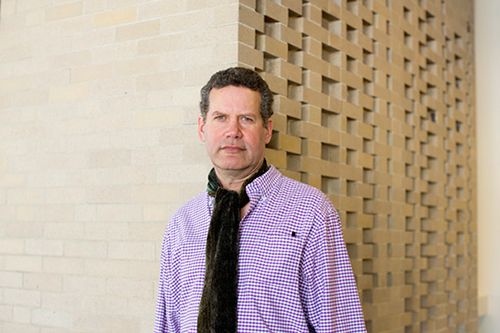Harvard Gazette: Eyes on ‘America,’ with Hopes of Drawing More
By Corydon Ireland, Harvard Gazette

Photo: Rose Lincoln/Harvard Staff Photographer
A wall is just a wall.
Unless it is a work of art hidden in plain sight.
That was the message of a lecture Tuesday at the Graduate School of Design — the first in “Then and Now,” a series on the legacy of the iconic architect Walter Gropius, courtesy of the Professor William Breger Fund. Gropius taught at Harvard from 1937 to 1952 and was credited with creating an American fervor for modern design. Introducing the lecture, Dean Mohsen Mostafavi said, “We want to use the series to make that history present.”
The messenger was Christopher E.G. Benfey, Ph.D. ’83, a professor at Mount Holyoke and a polymathic historian, memoirist, and literary critic. His focus: a floor-to-ceiling mosaic of yellow masonry brick called “America” (1950). In its Harkness Commons setting, the wall is little noticed despite its intricacy (inspired by the pre-Columbian Mitla ruins in Mexico) and its size (8 feet wide and 11 feet tall). To the casual viewer, Benfey said, it is nothing but “the backside of a fireplace.”
The wall’s designer was German-born American artist Josef Albers, a longtime Gropius friend from their days at the Bauhaus. The school, which opened in 1919, inspired a major current in architectural modernism. It was closed in 1933 by the rising Nazi regime, which saw its utopian, communal ethic as a threat to Germanic culture.
Both Gropius and Albers decamped to the United States: the architect to Harvard and the artist to Black Mountain College in North Carolina, an experimental, commune-like school (1933-1957) with more than a touch of Bauhaus to it. Albers put fine arts practice at the core of the curriculum. (“The Depression,” Benfey said, was “the last great era of progressive education,” a time of struggle that was mitigated by a sunny “aesthetic of newness.”)
Albers directed the painting program at Black Mountain until 1949. His wife, Anni, a fabric artist, was a colleague. Meanwhile, Gropius was eager for his friend to join him at GSD. But despite two decades of periodic teaching visits and a one-year appointment at Harvard in 1949-1950, Albers ended up at Yale.
Benfey, it turns out, was uniquely prepared to deliver “A Wall at Harvard,” a lecture about Josef and Anni Albers: They were his great-uncle and great-aunt, and he had recently written a related memoir on his family, “Red Brick, Black Mountain, White Clay” (2012). It is a dreamlike but exactly detailed rumination on the interweaving of objects, places, and personalities.
Read the entire article on Harvard Gazette.
